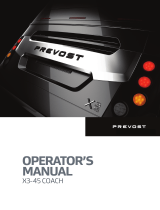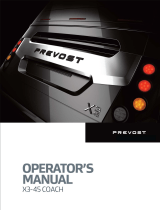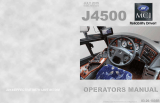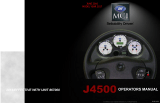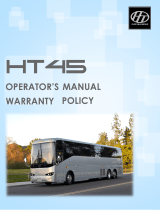
1-2 SAFETY PRECAUTIONS
SAFE OPERATING PRACTICES
To ensure safe and reliable operation, heed the
following safety precautions.
o Operation and maintenance of the vehicle
must be performed only by qualified
personnel.
o Before driving, conduct a walk around
inspection and check that all baggage
compartment doors and equipment access
doors are securely shut.
o Make sure good visibility is maintained at all
times. Keep windshields clean and free of
obstructions.
o Adjust the driver's seat so that all controls
can be reached easily.
o Always wear your safety belt when driving.
o Check the instrument panel frequently. Do
not operate the vehicle when dials or
indicators do not indicate normal operating
conditions.
o Always pay attention to pedestrians passing
in front and behind the vehicle. Always yield
to pedestrians at pedestrian walkways.
o Do not drive over obstacles on the road.
Empty boxes, piles of leaves, and snowdrifts
could conceal hidden dangers that could
damage the vehicle suspension and
underbody.
o When turning or changing lanes, signal your
intention well in advance.
o When approaching to make a right turn,
reduce the space between the vehicle and
the curb to make sure another vehicle
cannot pass on the right. Since the vehicle
makes wide turns, allow enough space to
make safe turns.
o Switch from high beams to low beams when
meeting or following other vehicles within
500 feet (150 meters).
o Never leave the vehicle unattended with the
engine running or with the key in the ignition.
Turn off the engine, remove keys and apply
the parking brake before leaving the vehicle.
o Shut-off the engine before refueling, adding
oil, performing maintenance or servicing
tasks, unless stated otherwise.
o Fuel is highly flammable and explosive. Do
not smoke when refueling. Keep away from
open flames or sparks.
o Do not run the engine or HVAC system with
access doors left open. Close compartment
doors before operating any equipment.
o Do not remove the surge tank filler cap or
the cooling system pressure cap when the
engine is hot. Let the engine cool down
before removing filler caps.
o Do not attempt to push or pull-start the
vehicle.
o The service life of the vehicle depends on
the kind of maintenance it receives. Always
record any problems and report them
immediately to maintenance personnel. After
each trip, perform a system diagnostic to
check if error codes and anomalies were
recorded in the vehicle electronic modules.
DEFENSIVE DRIVING PRACTICES
o For city driving, allow a four to six second
travel interval between your vehicle and the
vehicle ahead. Increase this travel interval
to six to eight seconds for highway driving.
Increase time interval for driving at night or
in foul weather.
o Be prepared to stop when approaching an
intersection. The stopping distance of the
vehicle increases with the weight and speed.
o Establish eye-to-eye contact with other
drivers and with pedestrians. Use, high
beam and low beam headlights, turn signals
and horn as needed.
o On highway, don't stare at the road ahead.
Keep your eyes moving. Check mirrors and
dashboard instruments frequently.
o To keep the vehicle from drifting across
lanes during highway driving, always look
over the horizon on the road ahead.
o Adjust your speed to road conditions, traffic
and visibility. Never exceed the posted
speed limits.
o If another vehicle is following close behind,
reduce your speed to let the vehicle pass.
For additional information about safe operation
and defensive driving practices, contact the local
department of motor vehicles authority.






















